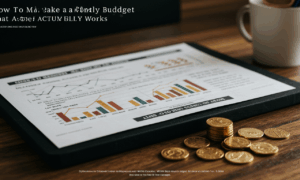How to Save Money Every Month: A Definitive Guide to Financial Health
Figuring out how to save money every month can often feel like a complex puzzle. With rising costs and unexpected expenses, setting aside a portion of your income may seem challenging, if not impossible. However, building a solid savings habit is the cornerstone of financial independence and security. This article is not about drastic sacrifices; it is about implementing smart, sustainable strategies that empower you to take control of your finances. We will provide you with a clear roadmap, actionable tips, and a structured approach to transform your financial habits and start building wealth consistently.
Whether you are saving for a down payment on a house, an emergency fund, or your retirement, the principles remain the same. It all starts with awareness, a plan, and discipline. Let us explore the practical steps you can take today to begin your journey toward a more secure financial future.
The First Step: Create a Realistic Budget
You cannot manage what you do not measure. The absolute foundation of saving money is understanding exactly where your money is going. A budget is not a restrictive tool meant to eliminate all fun from your life; it is a powerful instrument for financial awareness. Start by tracking all your income and expenses for at least one month. Use a spreadsheet, a notebook, or a budgeting app to categorize every single purchase.
Once you have a clear picture of your cash flow, you can create a realistic budget. A popular and effective method is the 50/30/20 rule. This framework suggests allocating 50% of your after-tax income to Needs (housing, utilities, groceries, transportation), 30% to Wants (dining out, entertainment, hobbies), and 20% to Savings and Debt Repayment. This provides a simple yet effective starting point that you can adjust to fit your personal circumstances and financial goals.

Analyze and Reduce Your Expenses
With your budget in hand, the next phase is to identify areas where you can cut back. Scrutinize your Wants category first, as this is often where the most flexibility lies. Are there subscriptions you no longer use? Can you reduce how often you eat at restaurants? Small changes can add up to significant savings over time.
Do not stop there. Also, review your Needs. While you cannot eliminate rent or a mortgage payment, you might be able to reduce other fixed costs. For example, shop around for a better deal on your car insurance, mobile phone plan, or internet service. Renegotiate bills where possible. Challenge every expense and ask yourself if it is truly necessary or if there is a more cost-effective alternative. Reducing your recurring monthly expenses creates a larger margin for savings that you do not have to think about each month. For more detailed strategies, explore our Savings section for targeted advice.
Automate Your Savings: The Power of Paying Yourself First
One of the most effective strategies for consistent saving is to make it automatic. The concept of paying yourself first means that as soon as you receive your paycheck, a predetermined amount of money is transferred directly into a separate savings account before you have a chance to spend it. This approach removes willpower and temptation from the equation.
Set up an automatic transfer with your bank. Decide on an amount you are comfortable with—even a small amount is a great start—and schedule the transfer for the day you get paid. By treating savings as a non-negotiable bill, you prioritize your future financial well-being. Over time, you can gradually increase the amount as your income grows or your expenses decrease. This single habit is a game-changer for building an emergency fund and working toward long-term investment goals.
Tackle High-Interest Debt
High-interest debt, particularly from credit cards, can be a major obstacle to saving money. The interest you pay on this debt effectively cancels out the progress you make in your savings. Therefore, creating a plan to aggressively pay down high-interest debt should be a top priority. Two popular methods are the Avalanche Method (paying off debts with the highest interest rates first) and the Snowball Method (paying off the smallest debts first to build momentum).
Choose the method that best suits your psychological needs and financial situation. As you eliminate each debt, redirect the money you were using for that payment toward your next debt target or directly into your savings. Freeing yourself from the burden of high-interest debt will dramatically accelerate your ability to save and build wealth. Managing your liabilities is a crucial part of your overall personal finance strategy.
Set Clear and Motivating Financial Goals
Saving money without a purpose can feel uninspiring. To stay motivated, it is crucial to set clear, specific, and time-bound financial goals. Instead of a vague goal like save more money, define what you are saving for. For example: Save €5,000 for an emergency fund in 12 months or Save €15,000 for a house down payment in three years.
Write your goals down and place them where you can see them regularly. Breaking down large goals into smaller, monthly targets makes them feel more achievable. For instance, saving €5,000 in a year translates to saving approximately €417 per month. This clarity gives you a tangible target to aim for with your budget and helps you make conscious spending decisions aligned with your long-term aspirations.
Conclusion
Learning how to save money every month is a skill that compounds over time. It begins with understanding your financial landscape through budgeting, followed by strategically reducing expenses and automating your savings. By tackling high-interest debt and setting clear goals, you create a powerful system for financial success. Remember that consistency is more important than perfection. Start with small, manageable steps, and build upon them. Taking control of your finances is one of the most empowering actions you can take, paving the way for a future of stability, freedom, and opportunity.
Frequently Asked Questions (FAQ)
What is the most important first step to start saving?
The most critical first step is to gain full awareness of your financial situation. This involves meticulously tracking your income and all your expenses for at least a month. Without knowing where your money is going, it is impossible to create an effective plan to save it. This tracking process allows you to build a realistic budget and identify areas for improvement.
How much of my income should I aim to save?
A great benchmark is the 50/30/20 rule, which suggests allocating 20% of your after-tax income to savings and debt repayment. However, this is just a guideline. The ideal amount depends on your individual income, expenses, and financial goals. The key is to start with an amount that is sustainable for you, even if it is small, and gradually increase it over time.
What should I do if my expenses consistently exceed my income?
If your expenses are higher than your income, you need to take a two-pronged approach. First, conduct a thorough review of your budget to identify and eliminate all non-essential spending. Second, explore ways to increase your income, such as asking for a raise, developing new skills for a better-paying job, or starting a side hustle. If your financial situation is complex, consider seeking advice from a financial professional with demonstrable experience.



